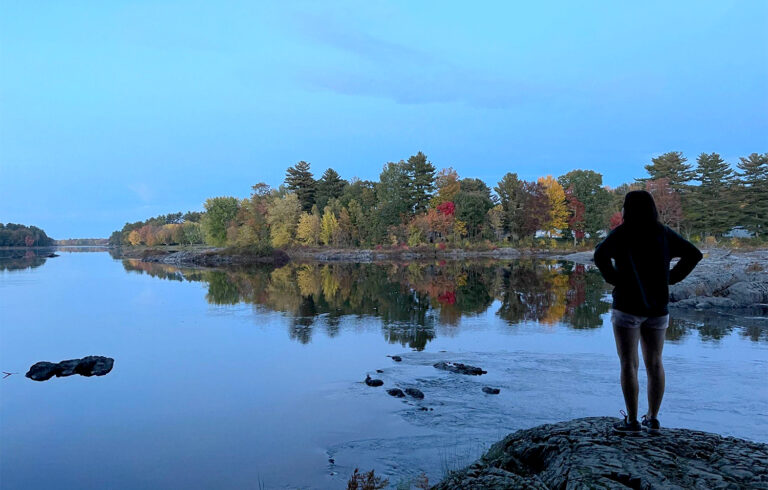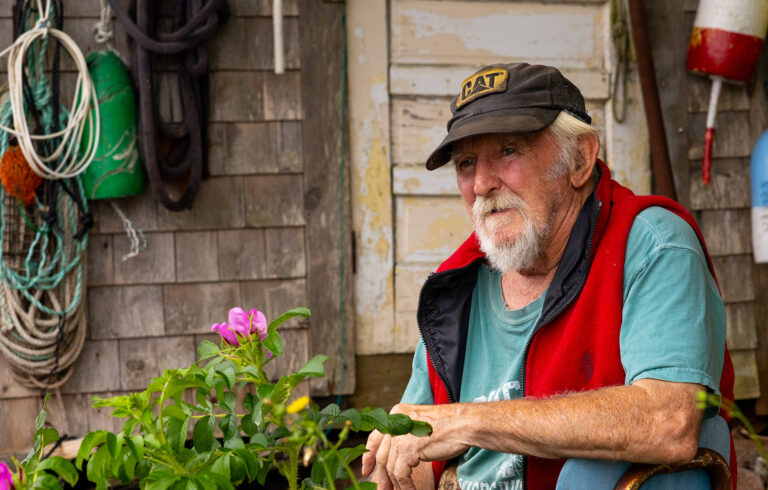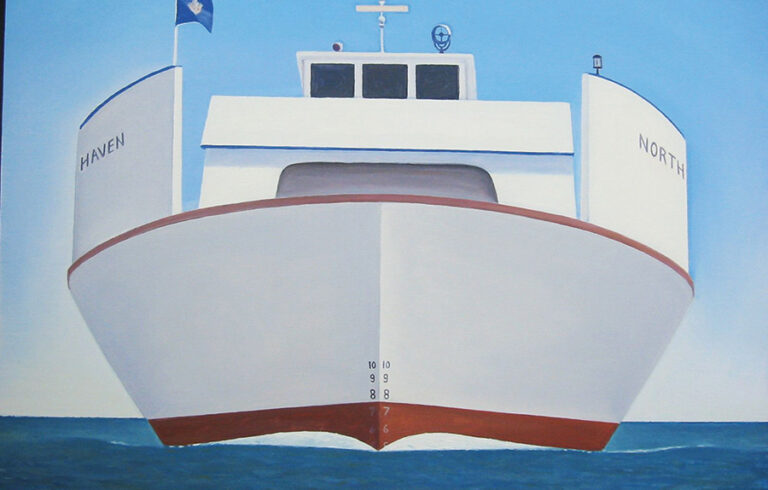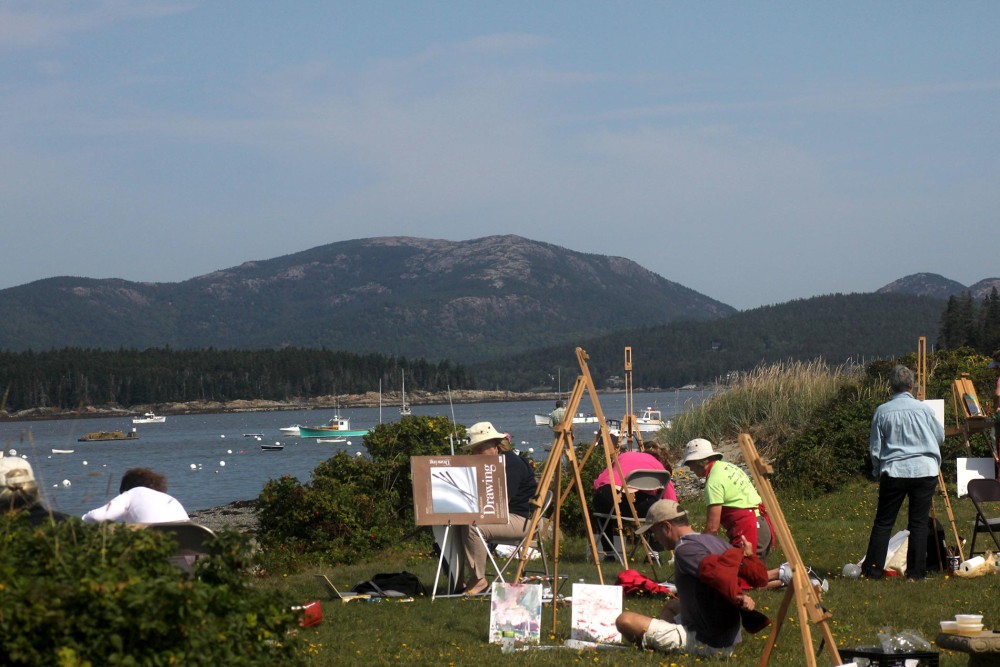
The Cranberry Isles consist of five islands that, in the words of the historian Ted Spurling, “fit into the Great Harbor of Mount Desert Island, nestling nicely under its shorter arm.” They are, from largest to smallest, Great Cranberry, Little Cranberry (also called Islesford), Sutton, Baker and Bear.
The islands first became associated with the arts in the 1840s and ’50s, when a number of landscape painters visited Mount Desert Island and vicinity. Alvin Fisher, from Boston, Thomas Cole, from New York (and England before that), and Fitz Henry Lane, a Gloucester, Massachusetts, native, were among those artists who found subject matter among the Cranberries, making sketches and painting various views.
When shown in galleries and museums in East Coast cities, their images helped attract visitors to the region. As art historian and former Farnsworth Art Museum curator Pamela Belanger explained in Inventing Acadia: Artists and Tourists at Mount Desert (1999), these painters, and the travelers who took their cue from their canvases, transformed Mount Desert Island into a “mecca for the well-to-do, revolutionizing the local economy.”
The first artists to be, as it were, economically associated in a direct manner with the Cranberries may have been the Three Islesford Painters. From 1919 to 1929, Charles Edwin Kinkead, Harold Warren and Clarence Scott White spent part of each summer on Islesford. All of them had distinguished careers well beyond the ken of Downeast Maine, but joined forces to mount exhibitions and sell their work on Little Cranberry.
The TIPS, as they were known, displayed their paintings in the second-floor sail loft space of a building called the Blue Duck (site of the present-day Islesford Museum). In 1930, White broke away from his colleagues to begin his own annual exhibitions at the Asticou Inn in Northeast Harbor. Warren and Kinkead, still going by the acronym TIPS (with Three replaced by Two), had their last show in the Blue Duck in 1931.
The entrepreneurial art spirit of the Three Islesford Painters would not be truly revived until Dan Fernald, a lobsterman, and his wife, Katy, a high school math teacher, opened Islesford Artists Gallery in 1986. The gallery came about serendipitously: An artist visiting the island asked if he could store some paintings in the loft of Dan’s workshop. According to Katy, “People began to ask to see the pictures and inquired if they were for sale.”
The seed was planted: Here was a possible island business. The following winter, the couple removed the lobster buoys and rope and finished off the upstairs space, laying a wood floor and Sheetrocking the walls to create a space for displaying paintings. Eventually the gallery took over the downstairs lobster trap workshop.
The goal of the Fernalds from the start was to share the artwork of the community with island residents and visitors. Over the years they have exhibited a wide range of art, from the atmospheric charcoal landscapes of Emily Nelligan to the light-filled watercolors of Mark Howard. Today, the roster includes Edith Wright, Gail Collier, Holly Brooks, Susan Demchak, Peter Rudolph, and Eric Golias.
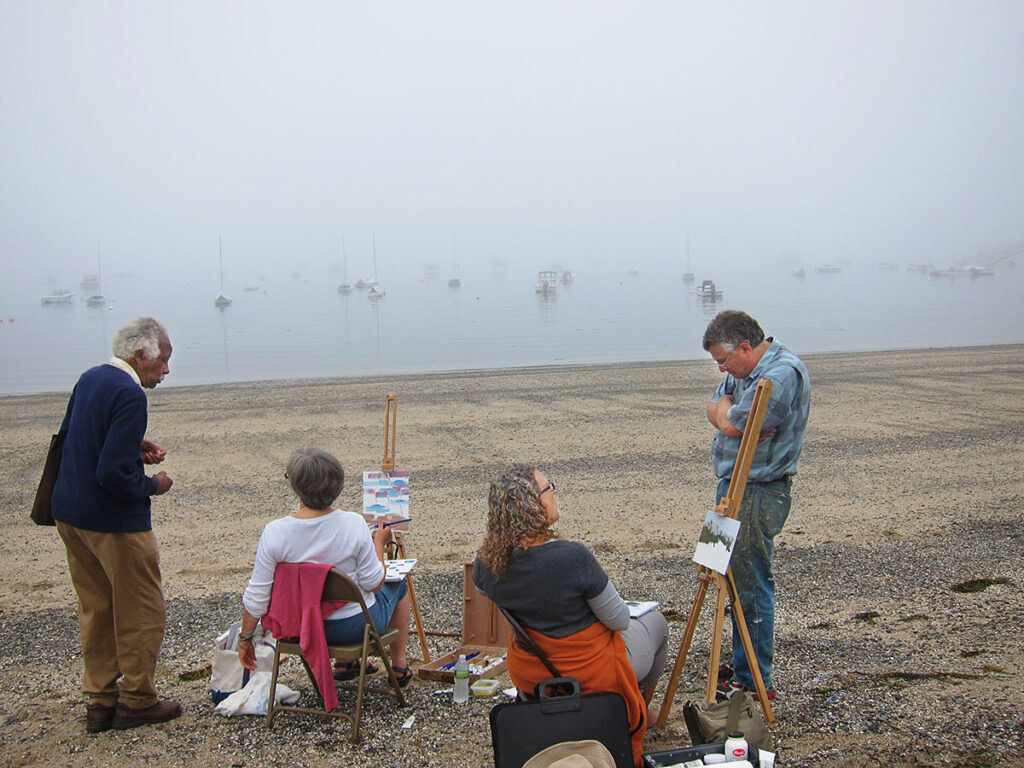
A parallel mission of the gallery was to encourage everyone to try their hand at making art. Dan Fernald proved to be the exemplar of the success of this effort: The sixth-generation lobster fisherman studied with island painters Ashley Bryan and Henry Isaacs and made a life in art. He is one of the gallery’s signature artists.
Islesford Artists was so successful that for a couple of years in the early 1990s the Fernalds opened an off-island branch in Northeast Harbor. While the second venue did well financially, running two galleries simultaneously seven days a week through the summer while maintaining the quality of the art took some of the fun out of the enterprise. In the end, they chose “to do one gallery and do it well,” says Katy.
The gallery has never followed the typical format of one-person or group shows that run for a few weeks and then change over. The place is a hub of ongoing creative activity: a still-wet oil painting hangs on a wall while fresh watercolors await matting and framing; a box of framed prints arrives on the mailboat. “The gallery is constantly changing to accommodate new images,” Katy explains.
At the same time, with its informal atmosphere the gallery has become a destination for visitors to the island. Seasonal residents bring their houseguests by. Word of mouth has been “the best advertising possible,” says Katy.
The gallery has helped support artists financially as well as provided “the moral support those sales can bring,” Katy reports. The connection artists make with visitors from around the world has been helpful. The gallery has also helped to attract artists to the island, some of whom have rented island homes.
The gallery has grown over the years, increasing sales each year until the economic slowdown occurred in 2009. This past summer sales improved substantially. With commissions in the works, Katy reports, 2012 may have been their best season ever.
“We would not be able to devote the time and energy to the gallery if we were not able to make a reasonable profit from it,” Katy explains. Like many Mainers, they piece together their annual income from several sources.
When Dan and Cynthia Lief opened the Islesford Dock Restaurant in 1992, the artwork they displayed on the walls of the eatery was provided by the Islesford Artists Gallery. Indeed, the Fernalds served as the couple’s art suppliers for many years.
When the Liefs made renovations to the restaurant in 2007, creating a new gallery space connected to the main dining room, they decided to run the art part of their business. Dan, a former banker, and Cynthia, an English teacher, embraced the role of gallerists, traveling across Maine and beyond to visit artists. They also quizzed art dealers about how to run the business.
The Liefs learned that a gallery can, in Cynthia’s words, be a “really enigmatic business, so random, so crazy.” As she notes, “Just because you absolutely love something doesn’t mean that someone else will.” They have often wondered, “Should we hang what we think will sell or what we like?”
All along they have remained open to ideas. Last summer they tried showing photography for the first time and were happy to do well with it. Their stable of artists has shifted from year to year. A short list includes Lois Dodd, Susan van Campen, Robert Pollien, Henry Isaacs, Lesia Sochor, Andrea Peters, and Judy Taylor.
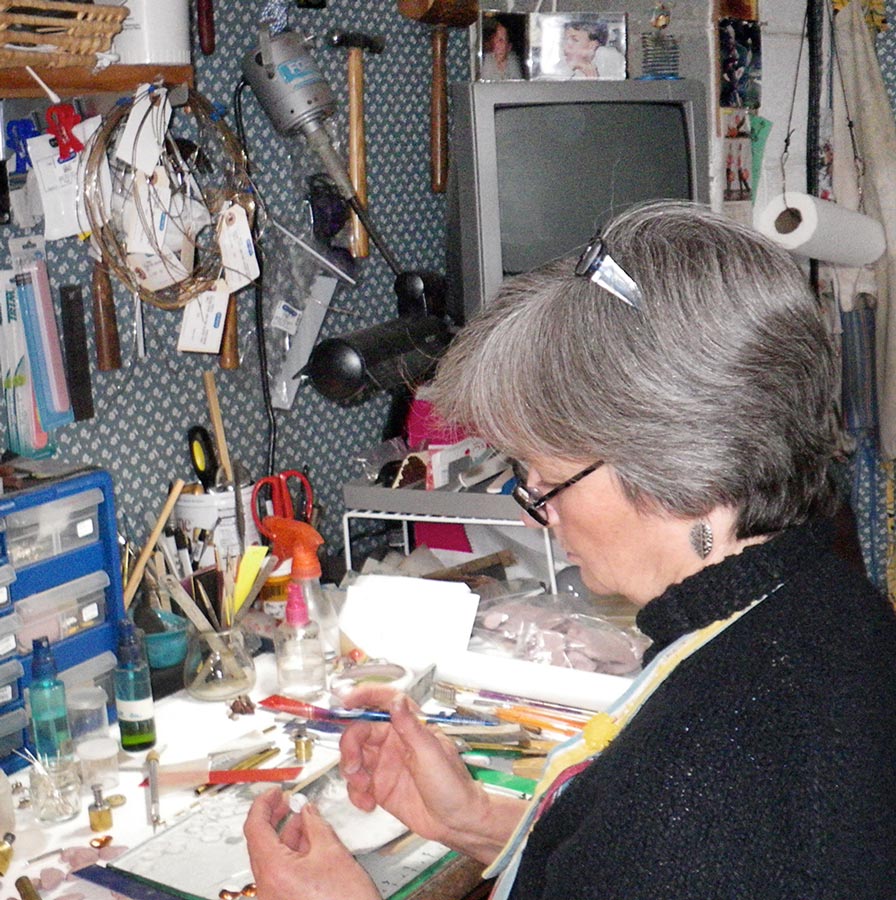
Like the Fernalds, the Liefs have watched their art business improve a bit each year, although they wish sales were stronger. They, too, acknowledge the short season, a 12-week stretch that barely lets up. August is their busiest month for art sales, followed by September, when island visitors often call to purchase the painting they had been looking at that summer.
The Liefs have tried stretching the season at both ends, but, as Dan explains, “There is no business for us in any significant way—not enough to justify the time and effort.” The restaurant and gallery are not tourist businesses, he notes. By their estimation, the clientele consists of around 65 percent summer people, 25 percent year-round, 5 percent people on sailboats and 5 percent day-tripping tourists.
Five years ago, in the midst of the recession, the Liefs’ best-selling island artist, Henry Isaacs, was wondering if they would sell any of his work come June. They came up with the idea to host a painting workshop, led by Isaacs and Ashley Bryan in early September after the restaurant closed for the season.
The first summer 25 people attended the weekend; the following year they sold out, so they added a second workshop. Since then they have offered the workshops every September.
The workshops have been a “huge addition” to the restaurant—and to the Liefs, who have reveled in the company of artists from across the country. The restaurant’s chef stays on to provide meals for the visiting students, and they rent summer cottages for their guests—“Soup to nuts,” Dan says, “everything included,” with the focus entirely on making art. “You shouldn’t have to think about anything but your painting,” says Cynthia.
The weekends are anchored by Isaacs, who taught for many years at the Massachusetts College of Art, and Bryan, who, in addition to being an award-winning children’s book author and illustrator, was chairman of the art department at Dartmouth College. The island recently renamed its school the Ashley Bryan School in honor of the artist, who turns 90 this year.
The Liefs have done minimal advertising for the workshops, relying on word of mouth and robust e-mail lists. They’ve had guests from Nashville, Nevada, and Seattle, but also from close by. Sam Shaw, a jeweler who operates a successful shop and gallery in Northeast Harbor and who has a home on Islesford, attended one of the workshops. He told the Liefs that the last time he had drawn was as an undergraduate at the Rhode Island School of Design in the 1970s.
“What do we do with this model?” Dan Lief wonders aloud. He and Cynthia question whether the business itself would be sustainable for someone who needed to support themselves year-round. “It’s a problem for all of Mount Desert Island,” Dan says. “Summer is so short.”
For now, the couple plans to keep running the restaurant, gallery, and workshops with the hope that “someday someone” will want to take it over. “The dock is a very important part of the island,” says Dan, adding, “It has been good fun.”
The dock was a hub of artistic enterprise before the Liefs arrived on the scene. Master ceramist Marian Baker had opened Islesford Pottery in 1989, and Sue Hill ran Winter’s Work. Both shops serve as the artistic counterparts of the Lobsterman’s Co-op on the next pier over, representing many different artists, from on and off the island.
Among the local entrepreneurs is Barbara Fernald, an award-winning jeweler, who has managed her business from Little Cranberry since the 1970s. The advantage of having an art business on the island, she notes, is that “if you are a good enough artist, you can provide employment for yourself in a community with limited opportunities for other kinds of employment.”
Self-motivation and deadlines to produce work for stores and galleries help Fernald remain focused. “I think artists adjust to the finite heavy summer business if they have other outlets for selling work away from the island during the other seasons,” she explains.
Obtaining her materials on the Internet, Fernald must take into account shipping time and plan accordingly. “I can’t just run into town and pick up what I need,” she notes. She does not sell her jewelry out of her island studio, but rather places it on consignment with Winter’s Work and several off-island venues.
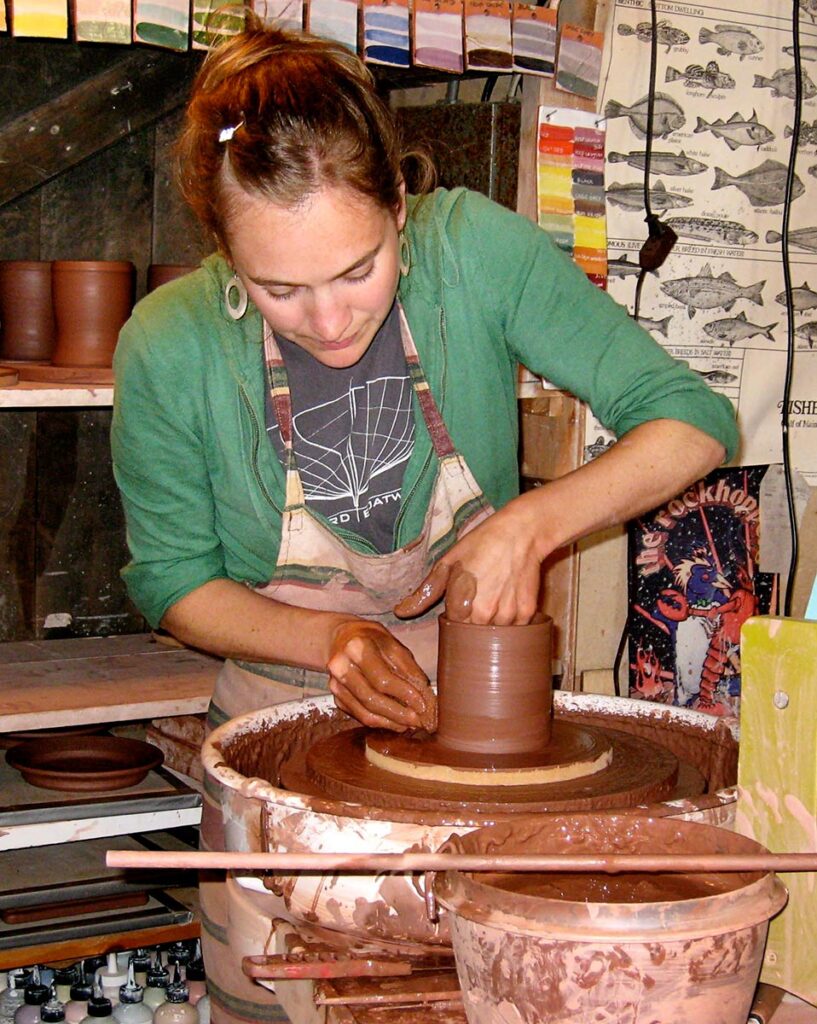
Among the most recent additions to the Islesford creative economy is potter Kaitlyn Duggan. Born in Sanford, Maine, she moved to Woolwich when she was nine. She spent her first summer on Little Cranberry in 2006. She graduated from the Maine College of Art the next year and returned to the island the following three summers.
In September 2008, Duggan married on the island. She and her husband decided to spend their first year together on Islesford. They bought a house in the spring and have been living there full-time ever since.
Duggan had an entrée to an island business. Marion Baker, owner of Islesford Pottery and a ceramics professor at the Maine College of Art, invited her to become her “co-potter” for the summer of 2006. “It was an opportunity to live on an island, work in a pottery shop, make all my own work, and sell it to the public,” Duggan notes. She also gained experience running a small business, studio, and gallery.
Baker and Duggan share the studio, taking turns running the shop and dealing with customers. As the season is short—mid-June through September—they end up being in the shop-studio nearly seven days a week. A percentage of Duggan’s sales goes to Baker to help cover rent, firing costs, and other expenses. They are always producing new work throughout the summer and also carry the work of several other potters.
Duggan’s pottery business has, she says, been boosted “tremendously” through her association with Islesford Potters. “My work has been exposed to thousands of summer visitors from all over the country and abroad,” she reports. Special orders keep her busy all summer and into the winter. During the off-season she builds up her inventory for the following summer.
Duggan and Fernald have websites to present and promote their work—a place for people to view their work if they can’t make it to the island. Their Facebook pages have also been a way to stay in touch with customers, share what they are working on from time to time, and announce special events. Duggan also takes part in the MECA Holiday Sale every year, which keeps her connected with the Portland community. Archipelago in Rockland and The Grasshopper Shop in Ellsworth carry her work.
Duggan finds the summer season frenetic. “All the income comes in July and August,” she reports. “If we have a foggy stretch or bad weather, it can have a impact on sales.” She also points to the challenges of getting supplies from the mainland and “schlepping boxes of fragile pottery off the island for craft shows during the winter months.”
These challenges are largely offset by the connections made with customers each summer. “Once they get here,” Duggan says of visitors, “people are genuinely curious about all aspects of island living.” Enchanted by what they discover about Little Cranberry, many want to take something home with them as a way to remember their trip. Duggan and her fellow island artists and gallery owners are there to oblige them.
Currently, these four arts businesses on Islesford support not only their owner/proprietors, but dozens of other artists both on and off the island who have collectively provided another identity to this lobster-fishing community. And although perhaps not as well known as Monhegan, Islesford has become a destination, for artists and collectors of art alike.
Carl Little has written a number of books n Maine artists. Little lives and writes on Mount Desert Island.

